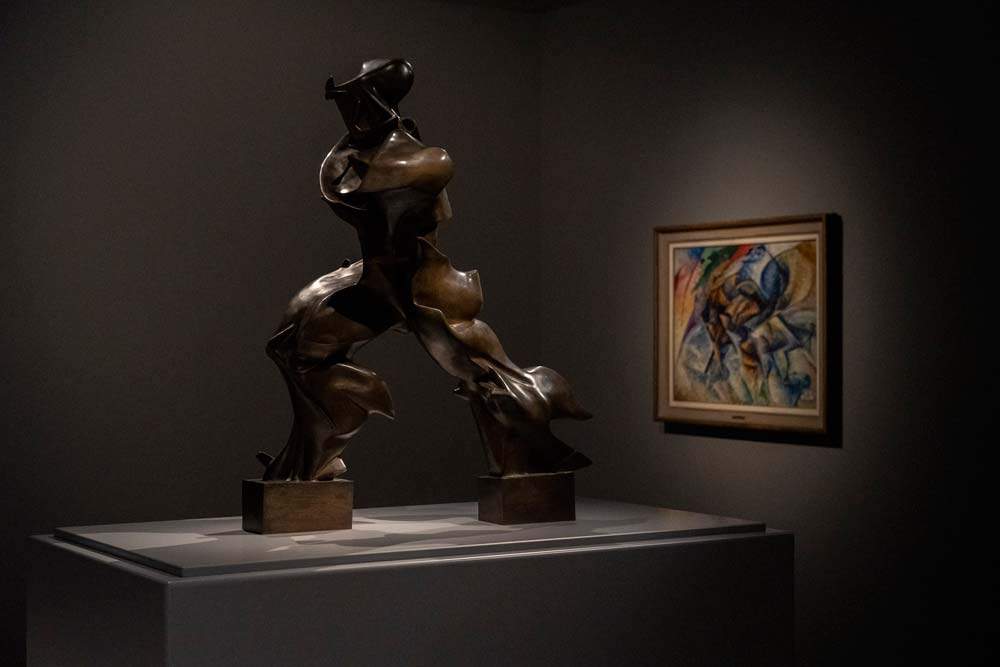Milan, the Museo del Novecento expands its spaces with the world's largest futurist nucleus
Milan ’s Museo del Novecento continues work toward doubling its exhibition spaces. The project kicks off with an exceptional occasion, the arrival of the Gianni Mattioli Collection consisting of twenty-six masterpieces of the early Italian twentieth century. From Umberto Boccioni to Mario Sironi, Amedeo Modigliani to Carlo Carrà and Giorgio Morandi, the new paintings dialogue in an organic and integrated path with the Museum’s permanent collection. The most conspicuous nucleus is presented in the Gallery of Futurism, the most internationally known Italian art movement, which precisely in Milan experienced its main events. Futurism is the current that radically marks the transition to modernity in the context of the cultural revolutions of the avant-gardes that invested the arts in Europe at the time. The interpreters of the new adventure were Umberto Boccioni, Giacomo Balla, Carlo Carrà, Gino Severini and Mario Sironi, who signed with founder Filippo Tommaso Marinetti the manifestos and programmatic documents in which the group’s poetic demands were outlined: dynamism, the “beauty of speed,” and modern life. The protagonists of that enterprise, when they are not touring or traveling the world with their own exhibitions, concerts and “futurist evenings,” meet in Milan at Marinetti’s home on Corso Venezia or in the lively restaurants in the Galleria.
Thanks to the Mattioli Collection, Milan will now boast the richest itinerary dedicated to futurism that exists in the world. Boccioni’s famous sculpture Unique Forms of Continuity in Space (1913), the museum’s icon, welcomes visitors in the first room, confronting two masterpieces by the same artist, Dynamism of a Cyclist (1912) and Dynamism of a Human Body (1913). Focal counterpoint, on the back wall of the long Gallery, stands the monumental painting Materia (1912), a portrait of the artist’s mother at a balcony, perhaps Boccioni’s most ambitious painting of the same artist, which brings together his most innovative expression in a true pictorial manifesto.
Between the two masterpieces runs the tale of Futurism from canvases, still divisionist in technique, to collages, from polymaterial compositions to painting tending toward abstraction: Crepuscolo (1909) and Boccioni’s sketch of La città che sale (1910), the iconographic swirl of Carlo Carrà’s Manifestazione interventista (1914), the unrestrained dancing in fashionable clubs depicted by Severini in La Chahuteuse (1912) and the swirling glitter of the Blue Dancer (1912) studded with sequins, and then again the study of movement and speed in Giacomo Balla’s works such as Mercury Transits Before the Sun (1914). The narrative continues with an unprecedented colloquy of two masterful portraits executed by Amedeo Modigliani a few years apart, that of the art dealer Paul Guillaume (1916) and the counterpart of his painter friend Franck Haviland (1914), with a pictorial layer played on the modes of the unfinished. The itinerary continues with new arrangements that allow works by Mario Sironi, such as Composizione con elica (1915) and Il cavallo bianco (1919) from the Mattioli Collection, to be juxtaposed in a splendid metaphysical triptych, side by side with Ballerina (1919) from the Jucker Collection, introducing the grandeur of the 1920s. Finally, a monographic room is dedicated to the painting of Giorgio Morandi, Gianni Mattioli’s favorite artist, with no less than six canvases from the Collection complementing the Museum of the Twentieth Century’s holdings in its tribute to the great Bolognese artist.
Gianni Mattioli, born in Milan in 1903, an art-loving businessman and friend of Futurists Depero and Azari, began collecting modern art with the intention of creating a collection of selected masterpieces of 20th-century art. Giacomo Rossi, Gianni Mattioli’s grandson, with a long-term loan for the benefit of the Museo del Novecento, thus wished to enhance and make public use of the collection, a sign of continuity with the educational and social intent of his grandfather, who had already opened an exhibition space in Via Senato to the public in the 1970s. The renovated exhibition galleries have been redesigned in collaboration with architect Italo Rota, author of the conversion of the Palazzo dell’Arengario into the spaces of the Museo del Novecento, and with whom the revision of the entire visit itinerary is being planned, progressively investing the rooms that will host in the coming years in-depth studies and focuses related to the museum’s rich and growing heritage.
The presentation of the Mattioli Collection marks “a fundamental stage in the development of the Museo del Novecento,” as Culture Councillor Tommaso Sacchi points out: “In view of the doubling of its spaces in the second Arengario, the Museo del Novecento continues to ’go up,’ like Milan’s famous Boccioni canvas: new important donations, new routes that trace itineraries in the fascinating but complex spaces of the Arengario, new ideas to tell the public the extraordinary story of the Italian Novecento. A museum as ’dynamic’ as Futurism, of which it now preserves the richest and most complete collection in the world.”
 |
| Milan, the Museo del Novecento expands its spaces with the world's largest futurist nucleus |
Warning: the translation into English of the original Italian article was created using automatic tools. We undertake to review all articles, but we do not guarantee the total absence of inaccuracies in the translation due to the program. You can find the original by clicking on the ITA button. If you find any mistake,please contact us.




























